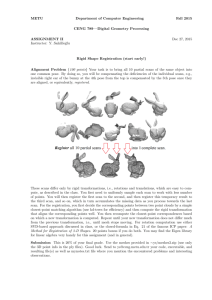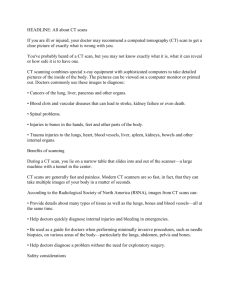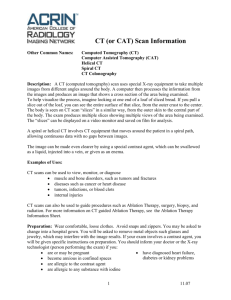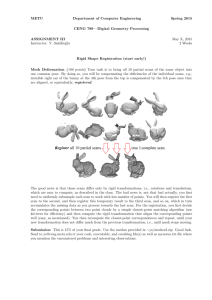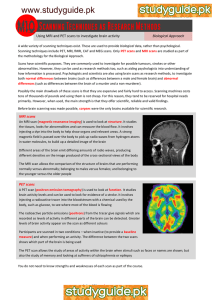MULTIPLE SCAN REGISTRATION IN LIDAR CLOSE-RANGE APPLICATIONS
advertisement
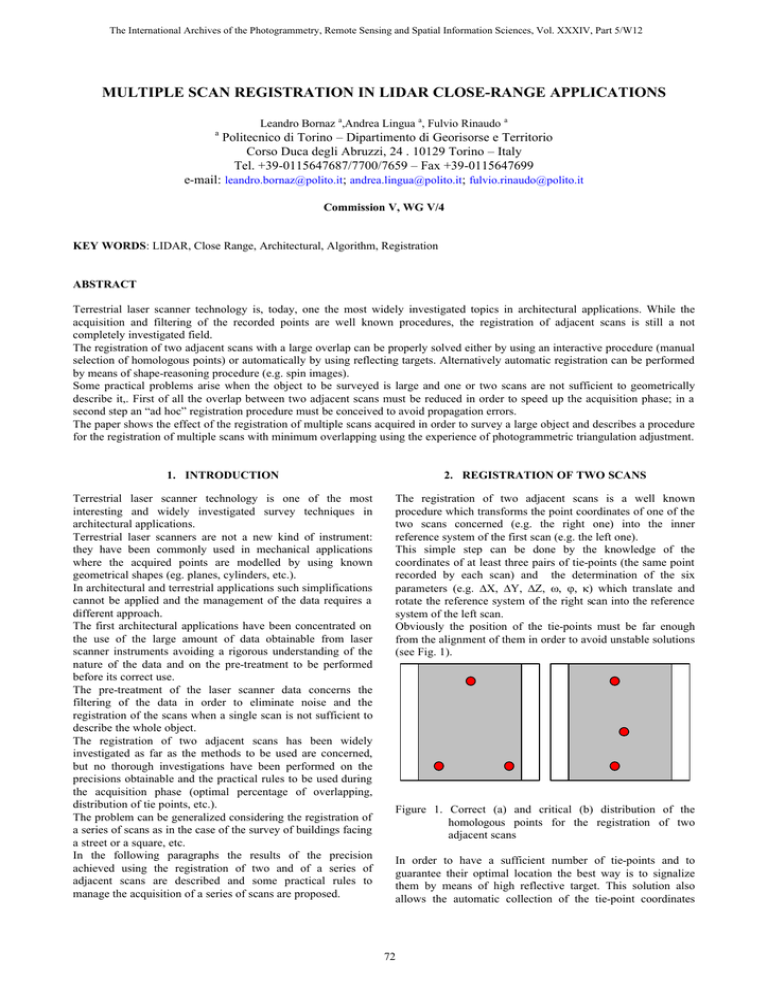
The International Archives of the Photogrammetry, Remote Sensing and Spatial Information Sciences, Vol. XXXIV, Part 5/W12 MULTIPLE SCAN REGISTRATION IN LIDAR CLOSE-RANGE APPLICATIONS Leandro Bornaz a,Andrea Lingua a, Fulvio Rinaudo a a Politecnico di Torino – Dipartimento di Georisorse e Territorio Corso Duca degli Abruzzi, 24 . 10129 Torino – Italy Tel. +39-0115647687/7700/7659 – Fax +39-0115647699 e-mail: leandro.bornaz@polito.it; andrea.lingua@polito.it; fulvio.rinaudo@polito.it Commission V, WG V/4 KEY WORDS: LIDAR, Close Range, Architectural, Algorithm, Registration ABSTRACT Terrestrial laser scanner technology is, today, one the most widely investigated topics in architectural applications. While the acquisition and filtering of the recorded points are well known procedures, the registration of adjacent scans is still a not completely investigated field. The registration of two adjacent scans with a large overlap can be properly solved either by using an interactive procedure (manual selection of homologous points) or automatically by using reflecting targets. Alternatively automatic registration can be performed by means of shape-reasoning procedure (e.g. spin images). Some practical problems arise when the object to be surveyed is large and one or two scans are not sufficient to geometrically describe it,. First of all the overlap between two adjacent scans must be reduced in order to speed up the acquisition phase; in a second step an “ad hoc” registration procedure must be conceived to avoid propagation errors. The paper shows the effect of the registration of multiple scans acquired in order to survey a large object and describes a procedure for the registration of multiple scans with minimum overlapping using the experience of photogrammetric triangulation adjustment. 1. INTRODUCTION 2. REGISTRATION OF TWO SCANS Terrestrial laser scanner technology is one of the most interesting and widely investigated survey techniques in architectural applications. Terrestrial laser scanners are not a new kind of instrument: they have been commonly used in mechanical applications where the acquired points are modelled by using known geometrical shapes (eg. planes, cylinders, etc.). In architectural and terrestrial applications such simplifications cannot be applied and the management of the data requires a different approach. The first architectural applications have been concentrated on the use of the large amount of data obtainable from laser scanner instruments avoiding a rigorous understanding of the nature of the data and on the pre-treatment to be performed before its correct use. The pre-treatment of the laser scanner data concerns the filtering of the data in order to eliminate noise and the registration of the scans when a single scan is not sufficient to describe the whole object. The registration of two adjacent scans has been widely investigated as far as the methods to be used are concerned, but no thorough investigations have been performed on the precisions obtainable and the practical rules to be used during the acquisition phase (optimal percentage of overlapping, distribution of tie points, etc.). The problem can be generalized considering the registration of a series of scans as in the case of the survey of buildings facing a street or a square, etc. In the following paragraphs the results of the precision achieved using the registration of two and of a series of adjacent scans are described and some practical rules to manage the acquisition of a series of scans are proposed. The registration of two adjacent scans is a well known procedure which transforms the point coordinates of one of the two scans concerned (e.g. the right one) into the inner reference system of the first scan (e.g. the left one). This simple step can be done by the knowledge of the coordinates of at least three pairs of tie-points (the same point recorded by each scan) and the determination of the six parameters (e.g. ∆X, ∆Y, ∆Z, ω, ϕ, κ) which translate and rotate the reference system of the right scan into the reference system of the left scan. Obviously the position of the tie-points must be far enough from the alignment of them in order to avoid unstable solutions (see Fig. 1). a) b) Figure 1. Correct (a) and critical (b) distribution of the homologous points for the registration of two adjacent scans In order to have a sufficient number of tie-points and to guarantee their optimal location the best way is to signalize them by means of high reflective target. This solution also allows the automatic collection of the tie-point coordinates 72 The International Archives of the Photogrammetry, Remote Sensing and Spatial Information Sciences, Vol. XXXIV, Part 5/W12 from the reflectivity images generated by the acquisition software of the scanner. When it is not possible to perform a signalisation, the correct choice of tie-points can be performed by using geometric reasoning algorithms (e.g. spin-images) but in these cases the search will succed only if the surveyed surface is rough enough. It is easy to understand that the precision of the registration is directly correlated to the “distance” between the alignment of the tie-points and their true location. Consequently, the minimum area circumscribing the optimal tie-point location can be interpreted as the minimum overlap between two adjacent scans. The results achieved by simulation have been confirmed by experimental tests. A test field has been realized on a building corner (see fig. 4). Using a RIEGL LMS-Z210 laser scanner (σr = ± 25 mm) five pairs of scan have been acquired using 90%, 70%, 50%, 30% and 10% of overlaps. 2.1 Simulation and experimental tests In order to define the minimum overlapping area between two adjacent scans, some simulations have been performed. Let us consider two adjacent scans with an overlap ranging from 90% to 10%. In each case three tie-points and three check-points (not used for the estimation of the transformation parameters) have been signalized (as shown in Fig. 2 in case of 90% overlap). Figure 4. Test field Figure 2. Tie-points (circles) and check-points (squares) The left scan is assumed to be acquired in the same reference system of the check-points. After the registration, computed by using tie-points, the right scan is transposed in the reference system of the left scan and the discrepancies between the check-point coordinates coming from the right and left scans have been determined. Figure 3 shows the results obtained: as long as the overlap is higher than 30% the discrepancies are of the same order of the acquisition accuracy (σr). Each overlapping space has been provided with 6 high reflective targets: three of them have been used as tie-points and the others as ground control points. All the targeted points have been surveyed by means of a total station. Each couple of scans has been registered using three tie-points and, after the registration, all the distances between all the existing ground control points inside the overlapping area, have been compared with those computed using the known coordinates (coming from the total station survey). Table 5 shows the discrepancies obtained. OVERLAP 90% 70% 50% 30% 10% DISCREPANCIES 5 σr Max 43 42 44 45 180 DISCREPANCIES [mm] Min Average 27 38 27 37 26 38 29 39 61 135 Table 5. “Two-scan” registration accuracy 2.2 Analysis of the results 2σr σr OVERLAP 10% 30% 90% Figure 3. Accuracy of the “two-scans” registration Considering the results achieved, it can be stated that at least a 30% of overlapping must be provided in order to get a registration of two adjacent scans without a loss in the precision of the laser scanner instrument used. The results presented in the previous paragraph, are obtained by using the minimum number of tie-points (three). This circumstance gives the minimum redundancy useful to test the reliability of the results themselves and shows that, also in a critical situation, a good solution to the registration problem is possible. Obviously the use of more than three tie-points regularly distributed inside the overlapping region represents the best way to provide a reliable and reasonable solution. The registration of two adjacent scans can be considered 73 The International Archives of the Photogrammetry, Remote Sensing and Spatial Information Sciences, Vol. XXXIV, Part 5/W12 similar to the photogrammetric triangulation performed following the independent models approach. In this case the adjacent model overlaps vary from 10% to 20%. For laser scanner acquisitions, the requirement of a minimum overlap of 30% can be justified by the absence of the projection centre of the common image of the two stereoscopic models (see Fig. 6). 4 Z X,Y Z X,Y 3 O3 O2 O2 O1 σ S/σ M mean σ S/σ M max 2 2 1 z y z 1 y x x 3 Figure 8. Precision of a single strip triangulation 1 z 2 z y x 6 (number of models between ground control points) i 9 12 In the following experimental test, performed in order to check whether the previous statement described is correct. y x 3.1 Test field Figure 6. Photogrammetric model link and registration of laser scanner acquisitions. 3. REGISTRATION OF A SERIES OF SCANS In many applications, both architectural and environmental ones, the object to be surveyed requires more than two scans. This is true for statues, columns, buildings, building facades on a street or a on a square, natural coastlines, mines, etc. The chain of the scans can be a ring (e.g. statues, isolated buildings) or a strip (e.g. building frontlines, coastlines, mines). In order to test the possibility of registration of a scan strip, the facade of the buildings of our Department has been used as a test field. The dimensions of the wall used are of 40 m in length and 8 m in height. 8 laser scanner acquisitions have been recorded with an overlap of 30% (see Fig. 9). The acquisitions have been done by means of a Riegl LMS Z210 laser scanner. Figure 7. Ring and strip chains of scans Following the similarity underlined in the previous paragraph, the registration of a long chain of scans can be seen as the problem of the photogrammetric triangulation of a single strip. The experimental experience in the field of aerial triangulation is illustrated in Fig. 8. The graph shows the link between the precision of the strip and the location of the used ground control points. In the graph, σS/σM is the ratio of the precision of the strip (judged on the control point coordinates m.s.e. after the adjustment) and the precision of the absolute orientation of a single stereomodel. In order to reach the desired precision (σM) at least one ground control point every three models must be used. Considering the results obtained as far as the minimum overlap between two adjacent scans is concerned, a chain of scans could be correctly registered by using at least one ground control point (known in an external reference system) every three scans. Figure 9. Laser scanner acquisitions 68 reflecting targets have been placed on the walls; they will be used both as tie-points, ground control points or check points during the test. The points 5 ÷ 32 are the tie-points which will be used during the registration of the adjacent scans (see. Fig. 10) The points 101 ÷ 132 are the points which will be used as ground control points and/or check points (see Fig. 11) The 68 targets have been surveyed by means of a total station and the coordinates have been computed in an external reference system. 74 The International Archives of the Photogrammetry, Remote Sensing and Spatial Information Sciences, Vol. XXXIV, Part 5/W12 3.2 Scan registration Using the reflecting targets inside each overlapping region, the 8 scans have been registered in the reference system of the first scan. way all the 6 remaining scans have been registered. Using the known coordinates of the targeted points, coming from the topographic survey, and those computed by the registration process, the discrepancies (distances between the know point and the calculated position expressed in meters) have been calculated. Figures 12 and 13 show the discrepancies obtained on tie and check points at the end of the registration process. 5 4 3 2 Figure 10. Overlapping areas and tie points 1 0 100 110 120 130 Discrepancies on check points [m] Max. 4,748 Min. 0,033 Mean 1,790 Figure 11. Scan areas and check points This step has been performed by using the L.S.R. software developed at the Politecnico di Torino and presented last year [Bornaz, 2002]. L.S.R. software allows the automatic search of the reflecting targets within a scan, the automatic search of the homologous points between two adjacent scans, the estimation of the rotation and translation parameters of the right scan onto the left scan and the computation of all the point coordinates in a given reference system (the one of the left scan or an external reference system defined by the operator). Figure 13. Discrepancies of the check points after the registrations. The registration of a series of scans show unacceptable errors (5 m!) mainly due to the propagation of accidental and systematic errors. The effect is the same as that obtained by concatenating a series of stereomodel along a single strip; figure 14 shows the graphically the effect of the deformation of the scan strip. 0,5 0,4 0,3 0,2 0,1 0,0 0 10 Max. Min. Mean 20 30 40 Discrepancies on tie points [m] 0,403 0,000 0,088 Figure 12. Discrepancies on tie points after the registrations The first scan has been translated in the external reference system used for the survey of the targeted points, than the second scan has been registered onto the first scan. In the same Figure 14. Graphical representation registration. of the scan strip 3.3 Scan strip adjustment The adjustment of the scan strip has been computed in two subsequent steps. First the strip has been fitted in the external reference system by using only 4 control points (see nr. 101,116,121,132 in Fig. 11) and considering the strip as a single rigid body. 75 The International Archives of the Photogrammetry, Remote Sensing and Spatial Information Sciences, Vol. XXXIV, Part 5/W12 Figures 15, 16 and 17 show the discrepancies (expressed in meters) on the tie and check points and the graphical representation of the scan strip after this approximate fitting; table 18 show the discrepancies on the control points after the approximate solution. The discrepancies have been reduced to a maximum value of 0.5 m, ten times smaller then the discrepancies of the previous step. These values are not yet acceptable considering the range accuracy of the used laser scanner (σr = ± 2.5 cm). approx. adj. registration 0,5 0,4 0,3 0,2 0,1 Figure 17. Graphical representation of the scan strip after the registration and after the approximate adjustment. 0,0 0 10 20 30 40 Discrepancies on control points Point nr. Discr.[m] 101 0,334 116 0,385 121 0,341 132 0,398 Table 18 Discrepancies on tie points [m] Max. 0,403 Min. 0,000 Mean 0,088 Figure 15. Approximate solution: discrepancies on tie points. 0,6 0,5 0,4 0,3 0,2 0,1 0,0 Figures 19, 20 and 21 show the discrepancies (expressed in meters) on the tie and check points and the graphical representation of the scan strip after the rigorous solution. Table 22 shows the discrepancies on the control points after the rigorous solution. 0,08 0,06 100 110 120 130 0,04 0,02 0,00 Discrepancies on check points [m] Max. 0,504 Min. 0,057 Mean 0,275 0 Figure 16. Approximate solution: discrepancies on check points. In order to reach the expected precision, a rigorous adjustment has been performed. Each scan has been considered as a separate object and tie points and control points have been considered with different weights (w = 1 the tie points and w = 2 the control points). All the fitting parameters have been recalculated and all the points of the 8 scans have been transformed in the external reference system. Only the four points 101, 116, 121, 132 have been used as ground control points: observing figure 11 it can be noted that the spatial location of the used control points is the same that the experience in photogrammetric triangulation suggests for the adjustment of a single strip (see Fig. 8). Max. Min. Mean 10 20 30 Discrepancies on tie points [m] 0,058 0,003 0,022 Figure 19. Rigorous solution: discrepancies on tie-points The similarity of the scan strips registration with the single strip photogrammetric triangulation has been confirmed. The only difference is to adopt an overlap between two adjacent scans higher then 30%. The results, represented in the previous and following figures, demonstrate that also by fitting more than two strips it is possible to obtain good accuracy. All the procedures described have been implemented in VISUAL BASIC language and will be integrated inside the L.S.R. software which, in the future, will represent an 76 The International Archives of the Photogrammetry, Remote Sensing and Spatial Information Sciences, Vol. XXXIV, Part 5/W12 academic software able to perform a complete and correct pretreatment of laser scanner data: robust filtering, registration of a series of scan, fitting of the registered scans in an external reference system. 0,12 0,10 0,08 0,06 0,04 0,02 0,00 100 110 120 130 Discrepancies on check points [m] Max. 0,096 Min. 0,005 Mean 0,028 Figure 20. Rigorous solution: discrepancies of the check points. 4. CONCLUSIONS The accuracy of the registration of two adjacent scans depends on the overlaps adopted. A minimum of 30% of overlap will assure a final precision comparable to the range precision of the instruments used. In this case it is not necessary to provide control points and the registration can be performed in the reference system of one of the two involved scans. The laser scanner techniques requires, in many cases, the registration of a series of scans. This is a mandatory rule when the object is very large, but it is also the case when surveying the surface of small objects with significant variations in depth in order to reduce the extension of the hidden parts due to the perspective effects. In these cases a series of control points, referred to an external reference system, must be provided. At least one control point every three adjacent scans must be provided avoiding the alignment of them. Using a minimum overlap of 30% the final precision is compatible with the range accuracy of the laser scanner used. All the above described tests have been performed in their minimal configuration, both in overlaps and number of control points. REFERENCES Kraus, K., 1994-1996. Photogrammetry Voll. 1,2. Dümmlers Verlag, Bonn. rigorous adj. Bornaz, L., Lingua, A., Rinaudo, F., 2002. A new software for the automatic registration of 3D digital models acquired using laser scanner devices. Proc. “Scanning for cultural heritage recording” pagg. 52-57. Boehler W., Heinz G., Marbs A., Siebold M., 2002. 3D Scanning Software: An Introduction. Proc. “Scanning for cultural heritage recording” pagg. 47-51. registration El-Hakim, S., Beraldin, J.-A., Picard. M., 2002. Detailed 3D reconstruction of monuments using multiple techniques. Proc. “Scanning for cultural heritage recording” pagg. 58-64. Figure 21. Graphical representation of the scan strip after the registration and after the rigorous solution. Discrepancies on control points Point nr. Discr.[m] 101 116 121 132 0,013 0,008 0,009 0,011 Cantoni, R., Vassena, G., Lanzi, C., 2002. Laser Scanning and Traditional Survey Integration to Build a Complete 3D Digital Model of "Sagrestia dell'Archivio di Stato a Mantova". Proc. “Scanning for cultural heritage recording” pagg.105-109. Beinat, A., Crosilla, F., 2002. A generalized factored stochastic model for the optimal global registration of LIDAR range images. Proc. ISPRS Commission III, Symposium 2002. AKNOWLEDGMENTS Table 22 The research has been financed by Italian Ministry of Education, University and Research (MIUR) project PRIN2002 (Nat. Resp. Prof. Carlo Monti – Research Group Resp. Prof. Fulvio Rinaudo). 77


